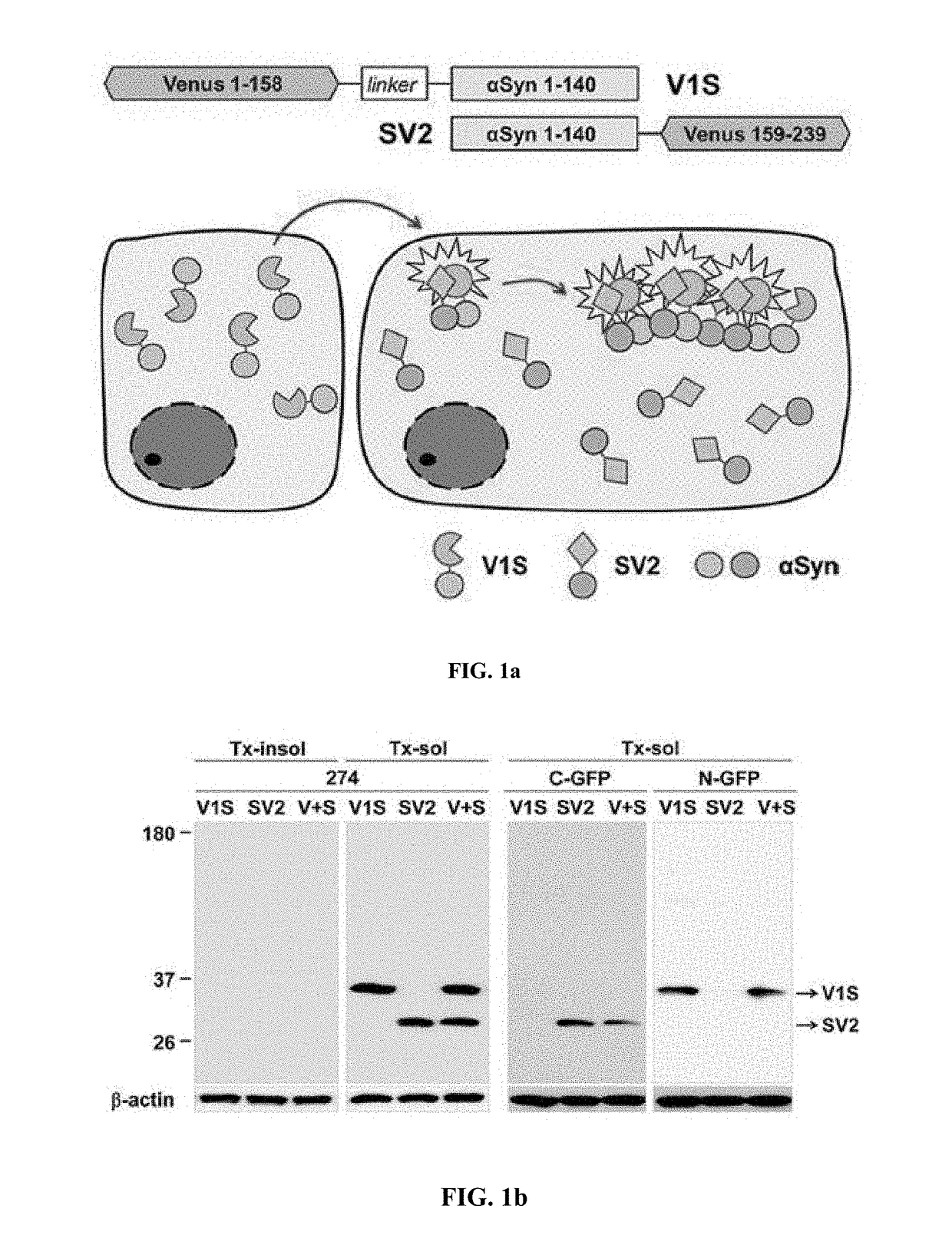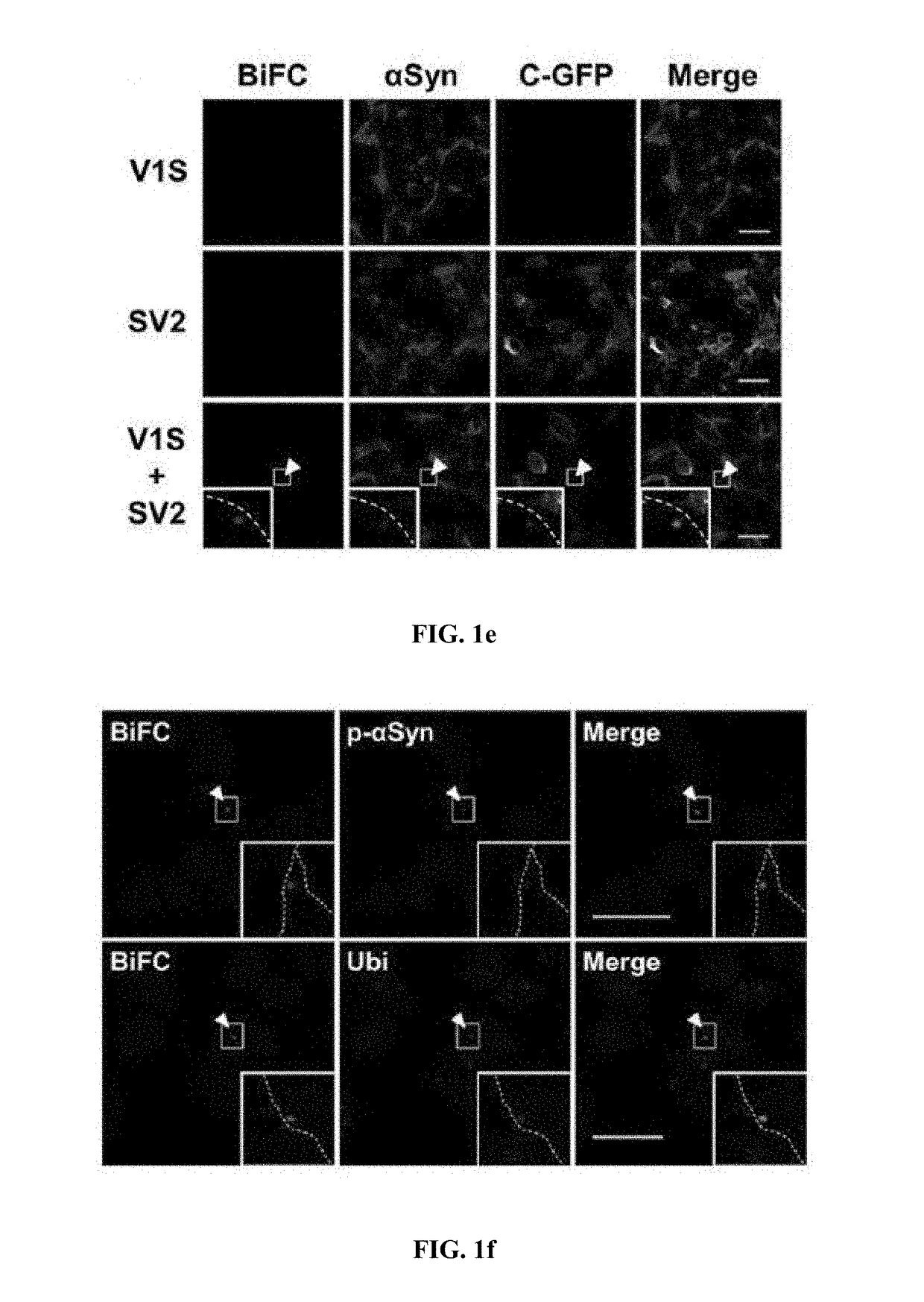Method for measuring cell-to-cell transmission of α-synuclein aggregates using bimolecular fluorescence complementation system and method for screening a substance for preventing or treating neurodegenerative disease using the same
a technology of -synuclein and cell-to-cell transmission, which is applied in the field of measuring cell-to-cell transmission of -synuclein aggregates using bimolecular fluorescence complementation system and screening a substance for preventing or treating neurodegenerative disease using the same, can solve the problems of reducing the activity of gba1, increasing the risk of cognitive impairment, and affecting the progression of synucleinopathy. , to
- Summary
- Abstract
- Description
- Claims
- Application Information
AI Technical Summary
Benefits of technology
Problems solved by technology
Method used
Image
Examples
example 1
Preparation of Dual-Cell Model and Measurement of Cell-to-Cell Transmission of α-Synuclein Using the Same
[0083]Experimental Materials and Processes
[0084]The following antibodies were used in the present disclosure: □□-synuclein monoclonal antibody (BD Biosciences; #610787, San Diego, Calif.), □□-synuclein monoclonal antibody #274, phosphorylated □-synuclein polyclonal antibody (Abcam, ab59264; Cambridge, Mass.), GFP (c-terminus) polyclonal antibody (IMGENEX, #5127A; San Diego, Calif.), GFP (N-terminus) polyclonal antibody (Cell signaling Technology, #2555; Beverly, Mass.), GFP (N-terminus) monoclonal antibody (Abcam, ab127417), GCase monoclonal antibody 8E4 (from J. Barranger, University of Pittsburgh), GCase polyclonal antibody (Sigma, G4171; St. Louis, Mo.), p62 monoclonal antibody (BD Transduction laboratories, #c2384-0B; Swampscott, Mass.), ubiquitin polyclonal antibodies (Dako; Glostrup, Denmark and Chemicon; Temecula, Calif.), and β-actin monoclonal antibody (Sigma). Fluoresce...
example 1-1
n of Stable Cell Lines
[0085]To prepare stable cell lines, SH-SY5Y human neuroblastoma cells were transfected with Venus1-αSyn (V1S) or □Syn-Venus2 (SV2) (obtained from Dr. Pamela McLean, Massachusetts General Hospital, Charlestown, Mass.) using electroporation. Transfected cells were selected with 600 mg / mL G418 (Invitrogen) for 2-3 weeks until colonies emerged. The stable cell lines were maintained with 200 g / mL G418.
example 1-2
of GBA1 Knockout (KO) Cell Lines
[0086]SH-SY5Y cells were transfected with plasmids encoding ZFN and a magnetic reporter (ToolGen; Seoul, Korea) using electroporation. After incubation for 48 h, the cells were subjected to magnetic separation. After trypsinization, the cells were mixed with magnetic bead-conjugated antibody against H-2Kk (MACSelectKkmicrobeads; Miltenyi Biotech; Germany) and the mixture was applied to a MACS LS column (Miltenyi Biotech). Single cells obtained from the eluates were maintained until the clonal colony was picked from the culture dish. Nonsense mutations in the GBA1 gene were confirmed using DNA sequencing.
PUM
| Property | Measurement | Unit |
|---|---|---|
| pH | aaaaa | aaaaa |
| pH | aaaaa | aaaaa |
| temperature | aaaaa | aaaaa |
Abstract
Description
Claims
Application Information
 Login to View More
Login to View More - R&D
- Intellectual Property
- Life Sciences
- Materials
- Tech Scout
- Unparalleled Data Quality
- Higher Quality Content
- 60% Fewer Hallucinations
Browse by: Latest US Patents, China's latest patents, Technical Efficacy Thesaurus, Application Domain, Technology Topic, Popular Technical Reports.
© 2025 PatSnap. All rights reserved.Legal|Privacy policy|Modern Slavery Act Transparency Statement|Sitemap|About US| Contact US: help@patsnap.com



